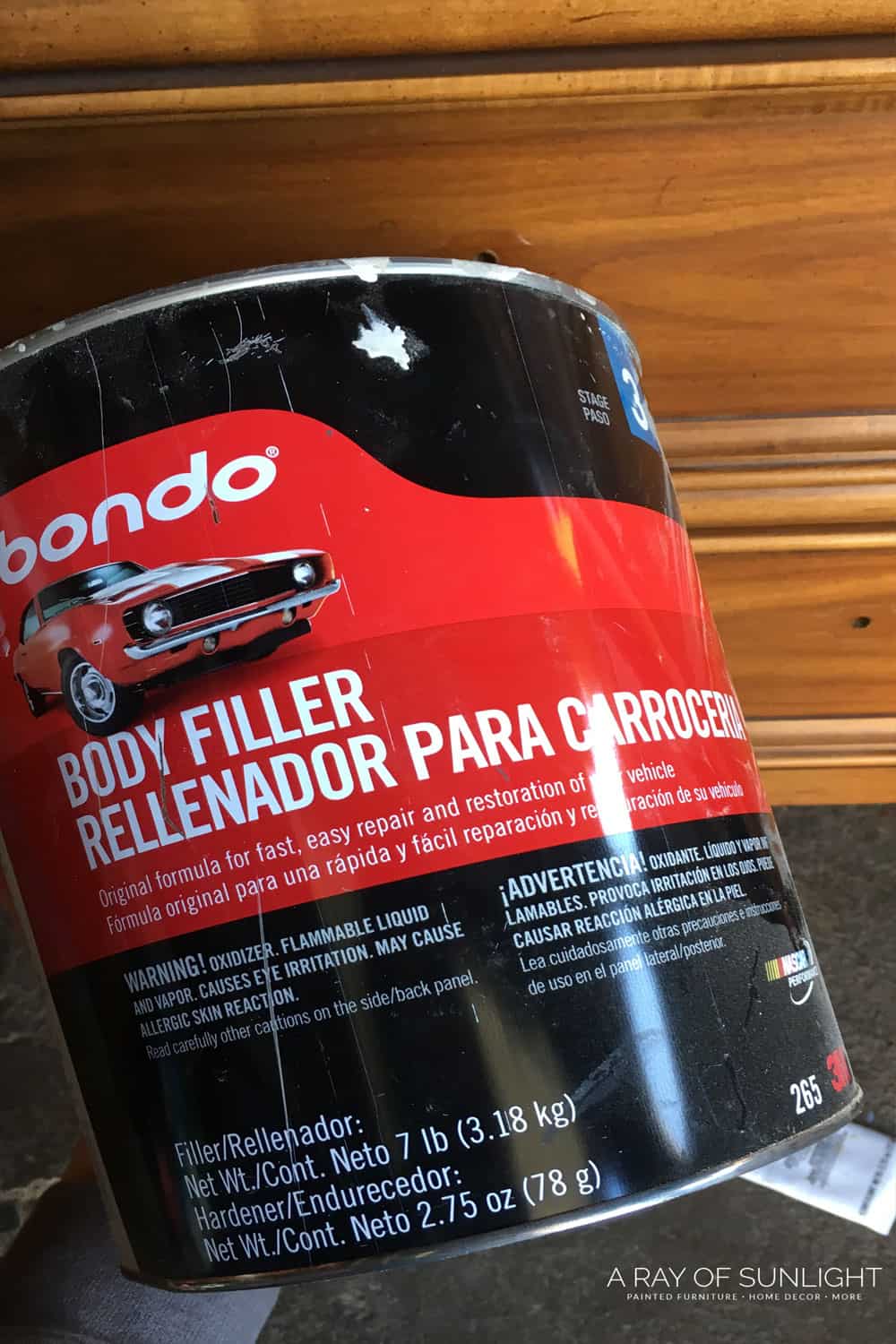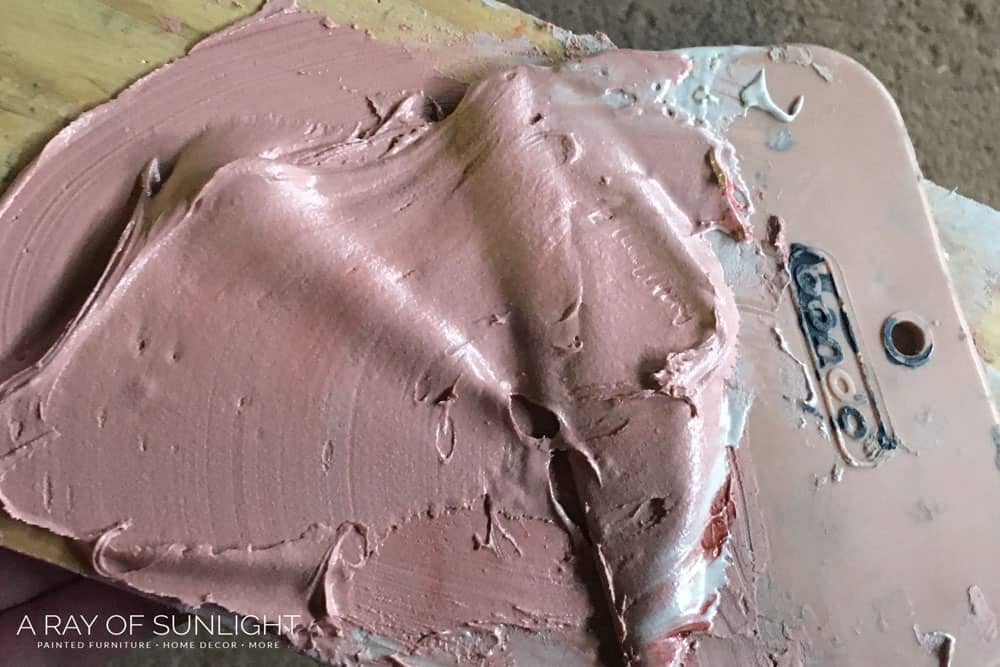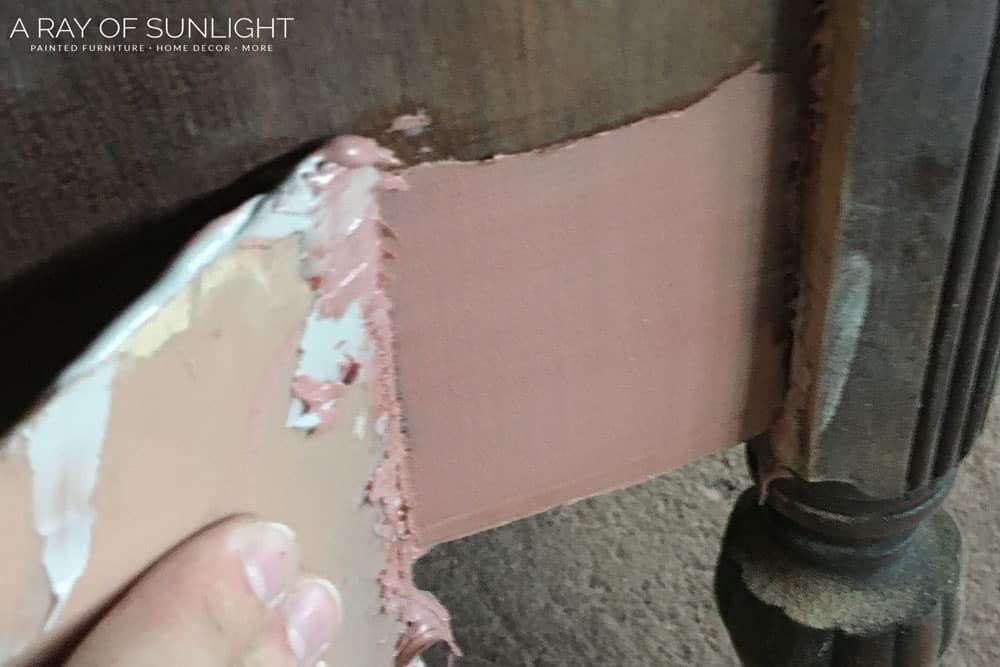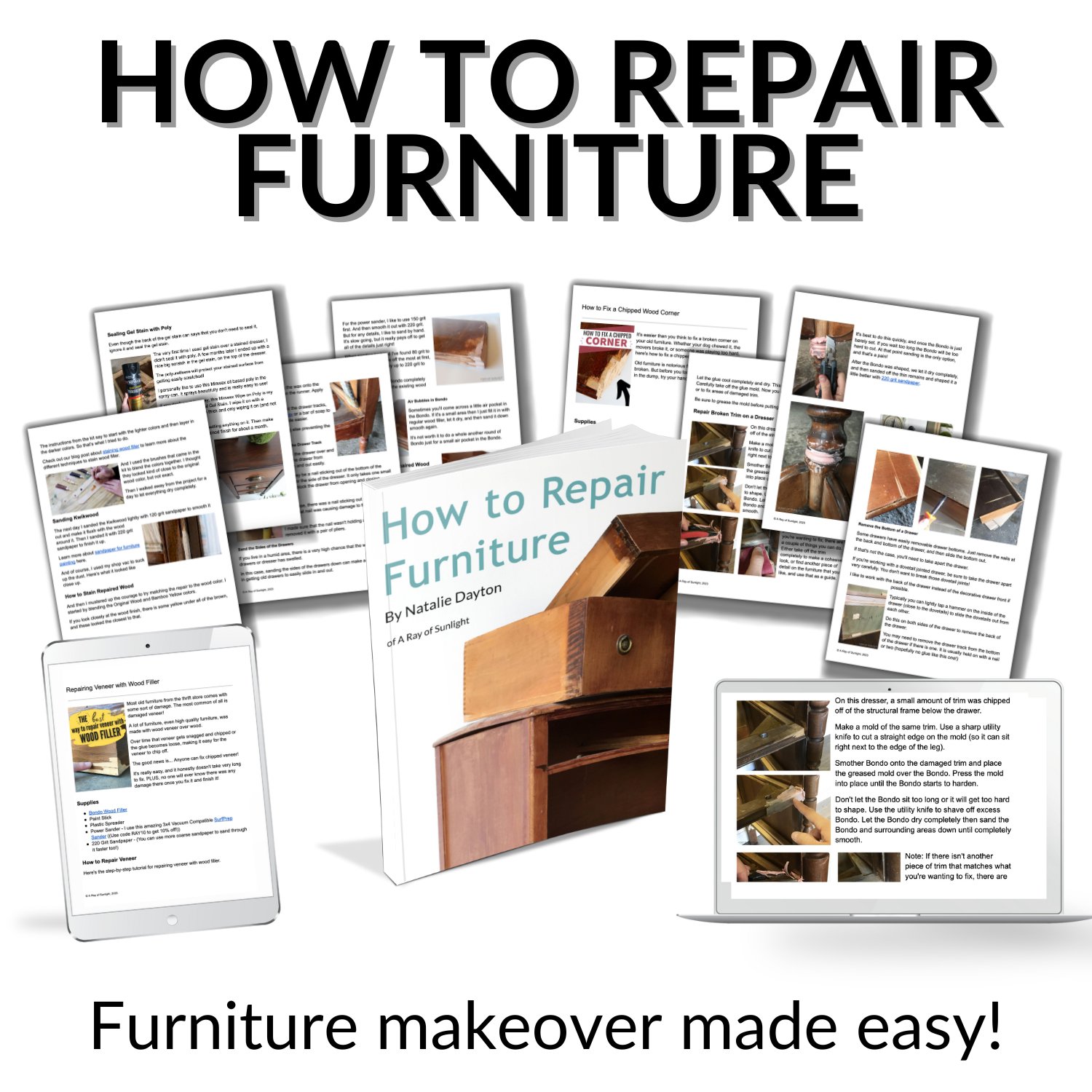The Best Way to Fix Chipped Wood Furniture
If you have ever encountered chipped wood in your home and wondered how to fix it, you are not alone. Repairing old furniture is a common task that many homeowners and DIY-ers face. So we’re sharing how to fix chipped wood furniture, specifically, how to repair veneer before painting.
Chipped wood furniture can be a real eyesore, but don’t worry, it’s a problem you can easily solve. And a little secret, this trick works for SO MANY furniture repairs!

A lot of antique furniture was made with real wood that had blemishes on it. But it was made beautiful with a thin layer of expensive, pretty wood. That thin layer of wood is called veneer.
The veneer was glued onto the less-pretty wood to make the less-pretty wood look like it was made of expensive wood.
This practice continues today with manufactured furniture, but today the wood under the veneer is often a manufactured (low-quality) wood.
Side Note: Wood veneer is different than laminate.
You can tell the difference between laminate and wood veneer by the sheen, texture and how they look. Laminate is very slick, shiny and has no natural wood grain (because it’s basically plastic that has been made to look like wood!) Wood veneer has texture, and it isn’t as slick or shiny as laminate is.
(Check out this post to see what you must do before you paint laminate furniture.)
Over time the wood veneer can get water damage, or the glue holding the veneer to the wood can become brittle, making the veneer loose.
Learn more on how to repair water damaged wood here.
When the veneer is loose, it starts to lift away from the wood, making it easy for the veneer to chip and break.
Here is a dresser that started to chip at the bottom. The veneer lifted and was easily broken off from the rest of the veneer.
Check out more ways on how to fix veneer that is lifting here.

I wanted to paint the dresser, but I didn’t want to leave the damage visible. This is such a common problem when painting or refinishing old furniture. But the fix is really pretty simple!
Supplies Used to fix chipped wood furniture
As an Amazon Associate, I earn from qualifying purchases. I also may earn from other qualifying purchases with other companies or get free product to review and use. All opinions are my own.
- Bondo
- Spreader
- Sandpaper
- Optional: Powder Sander / Sanding Disc
- Optional: Utility Knife
- Optional: Wood Filler
Fixing chipped wood furniture requires a few simple supplies you can find at any hardware store or online. It’s not that hard to get started, especially if you have the right ones for the job!

What Is Bondo?
Bondo is well known in the auto repair industry (but it’s become very popular to use on wood!) It’s a two-part product that consists of the base and the hardener.
Once mixed it dries very hard in less than an hour. Basically, it’s perfect for furniture and home repairs.
Bondo has actually come out with a wood filler version and a multi-purpose version because of how popular it has become! (Though I still like to stick with the good ole pink auto version of Bondo.)
Check out my in-depth Bondo wood filler review here to learn more about the wood filler version. Read through this post to know more options for the best wood fillers for furniture.

How to Use Bondo for Wood Repair
Simply mix a golf ball size of the base with about an inch-long amount of hardener.
Only mix it in small amounts or as much as you need though. About 5 minutes after it’s mixed, it becomes too hard to work with. And after about 30 minutes the Bondo is hard.

How Long Does It Take for Bondo to Dry?
It depends on the weather and how much hardener you mixed into the base, but it should be hardening enough that you can’t spread it after 5 minutes.
The back of the can says that it cures in 20 -30 minutes. After it has cured, you can sand it down.
How to Sand Bondo
If you can, sand the Bondo down with a power sander and 220 grit sandpaper. The power sander works the very best on a flat surface like the side of this dresser.
*Update: I have since upgraded and tried out a few different power sanders that I love even more than when I did this project! Read more about the best sanders for furniture here!


For sanding by hand, this is my absolute favorite sandpaper to use. I find that other sandpaper tears and loses it’s grit way too fast. Learn more about sandpaper for furniture painting here.
How to Sand Bondo Faster
If you’re repairing wood with details that are hard to get into, or areas where a power sander can’t get, I have a little trick that saves so much time!
About 5 minutes after you have put the Bondo onto wood, use a utility knife to shave off the excess and shape the Bondo.
Once the Bondo is dry and hard (about 30 minutes later) you can sand the rest of the Bondo down so it’s smooth and seamless.
Best Sandpaper for Bondo
This sandpaper isn’t just for Bondo. These are my favorite sandpaper sheets to use, no matter the project. They are great for hand sanding, or if you have a sander that uses sheets of sandpaper.
For my power sander, these are the sanding discs that I recommend. This brand is the best!
*Update: I have since upgraded my sander to this SurfPrep sander (3×4 vacuum-compatible) and I love it!
Do I Need to Apply a Second Coat of Bondo?
If there aren’t any imperfections, then you are just fine to move on to the next step.
But a lot of times the Bondo has air bubbles or small areas that need to be filled in to make the damage completely disappear.
You can either spread another thin coat of Bondo on, or you can put wood filler in those imperfections.

Once the Bondo or wood filler is dry, simply sand it down smooth again.
How to Paint Bondo
You can paint right over Bondo if you would like. But to combat bleed through or uneven coverage of paint, it’s best to prime the furniture in some way before painting.

I personally love to use clear shellac in the spray can to combat bleed through, and seal the Bondo.
I love to use shellac because it’s clear and makes it easy to lightly distress the paint for a farmhouse look. Read this post to learn more about the 6 best distressing furniture techniques!
If you don’t want a farmhouse look, a white primer like BIN shellac is perfect to get your furniture and Bondo repair ready for paint. Check out the best primers to stop tannin bleed here.
Note: If you are painting your furniture with powdered milk paint, I like to paint a coat of water-based poly over the Bondo. Shellac can make the powdered milk paint crackle, revealing the pink Bondo underneath, so water-based poly is the best option!
Read more about the best primers for painting furniture (and how to choose the right one) here!
Watch the full video of fixing chipped wood furniture with Bondo below:

Can You Stain Bondo?
Sadly, Bondo doesn’t take stain like wood does. Plus if you use the autobody kind (the pink stuff), it’s going to be even harder to make the Bondo look like wood.
Check out this wood stain repair tutorial to learn more.
But, Bondo has a wood filler version of Bondo that would be easier to stain. It still won’t take stain like wood does (no wood filler will stain like wood does though!).
Your best bet to stain Bondo is to use the wood filler version and then stain it by painting on layers of gel stain.
Check out this post on how to repair chipped veneer furniture to learn how to stain Bondo wood filler and this post to learn how to stain wood darker with gel stain!
This YouTube video from Family Handyman about how to patch veneer uses another product that I really love called KwikWood. It’s another great option to repair the chips in wood veneer.
KwikWood is a thicker, clay-like, wood filler that can be shaped easily. It also dries quickly (about an hour) and dries hard. Learn more about how to use KwikWood here if you’re not familiar with it.
It’s not as easy to fill in a large area of missing veneer with Kwikwood though, so I like to stick to Bondo for repairs like this.
Get the Secrets!
Grab this super convenient How to Repair Furniture Ebook with all of our secrets on how to repair furniture for only $14.
You can print it out and have instant access whenever you come across damaged furniture, and know exactly how to fix it!
Click on the picture of the book to purchase!
Remove Veneer – Optional
If your veneer is loose or pretty damaged, you might want to remove all of it instead of filling in the modding veneer. Here is our video and tutorial on the insanely easy way to remove veneer.
You’ve got this!!
More Repairing Furniture Resources
- How to Fix Old Dresser Drawers that Stick
- How to Fix a Chipped Wood Corner
- How To Fix Dog Chewed Wood Trim
- How To Repair Damaged Wood Finish
- How To Repair Veneer Edging
Follow us on YouTube to get more tips for painting furniture.
Or share your project with us on our Facebook Group and be part of our community. See you there!










You really out do yourself explaining the full detail of how to do this properly. Thank you so much for the great work.
I can’t find the dresser “after” pic that was in the removing the veneer video. Can you share the link please?
Hey! I haven’t posted that dresser makeover on my website yet, but here is the video for that raw wood dresser makeover https://youtu.be/uZIhGiYfuCg
What do you do with the dresser after you remove the veneer? I have a old sewing machine that got wet and is peeling off, I would like to scrape it off and paint it but I’m afraid it will look bad. Or the wood won’t be good enough to stand up to repurposing as a bar cart. Any help would be greatly appreciated.
I typically paint it once I fix the veneer.